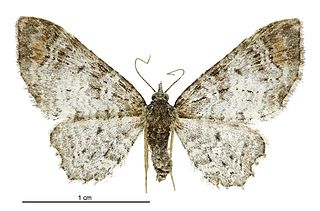
Falcaria lacertinaria, the scalloped hook-tip, is a moth of the family Drepanidae. The species was first described by Carl Linnaeus in his 1758 10th edition of Systema Naturae It is found in Europe and Anatolia then east to Eastern Siberia.

Pasiphila aristias is a species of moth in the family Geometridae. It was described by Edward Meyrick in 1897 and is endemic to New Zealand. This species is found in both the North and South Islands and inhabits subalpine and native forest. Adults are on the wing in December and January and are attracted to light.
Thiotricha acrantha is a moth of the family Gelechiidae. It was described by Edward Meyrick in 1908. It is found in Assam, India.
Anadasmus pelinitis is a moth of the family Depressariidae. It is found in Colombia.
Stenoma gymnastis is a moth of the family Depressariidae. It is found in Guyana, French Guiana and Brazil.
Anadasmus pelodes is a moth of the family Depressariidae. It is found in Mexico, Panama, Guyana and Brazil (Amazonas).
Stenoma bicensa is a moth of the family Depressariidae. It is found in Brazil and Panama.
Stenoma surinamella is a moth of the family Depressariidae. It is found in the Guianas and Brazil.
Stenoma sericata is a moth of the family Depressariidae. It is found in Brazil (Amazonas) and French Guiana.
Stenoma inflata is a moth of the family Depressariidae. It is found in the Amazon region and French Guiana.
Stenoma thespia is a moth of the family Depressariidae. It is found in French Guiana.
Stenoma oblita is a moth of the family Depressariidae. It is found in Brazil (Amazonas) and French Guiana.
Antaeotricha bicolor is a species of moth of the family Depressariidae. It is found in Brazil.
Gonionota erotopis is a moth in the family Depressariidae. It was described by Edward Meyrick in 1926.
Gonionota festicola is a moth in the family Depressariidae. It was described by Edward Meyrick in 1924. It is found in Peru.
Gonionota ioleuca is a moth in the family Depressariidae. It was described by Edward Meyrick in 1912. It is found in Argentina.
Gonionota lecithitis is a moth in the family Depressariidae. It was described by Edward Meyrick in 1912. It is found in Argentina.
Gonionota oligarcha is a moth in the family Depressariidae. It was described by Edward Meyrick in 1913. It is found in Peru.
Gonionota saulopis is a moth in the family Depressariidae. It was described by Edward Meyrick in 1909. It is found in Bolivia and Peru.
Anchinia porphyritica is a moth in the family Depressariidae. It was described by Edward Meyrick in 1914. It is found in Assam, India.

